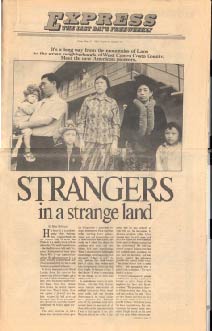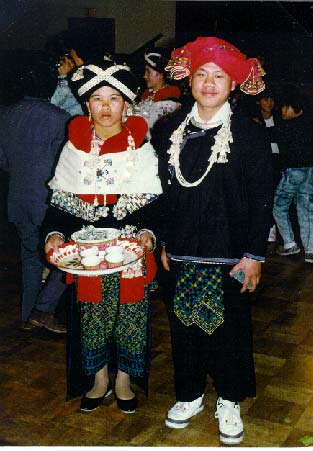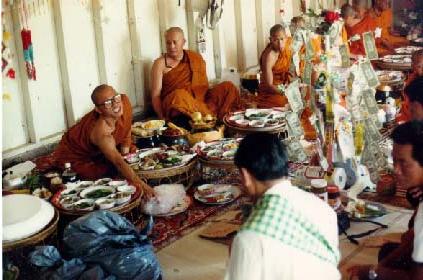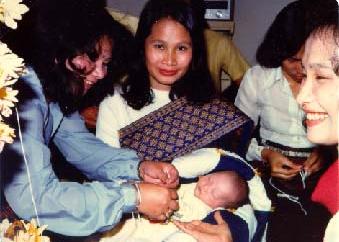

The Laotian American population is characterized by the diverse cultures and languages of its many ethnic groups. The ethnic, or lowland, Lao (Lao Loom) are linguistically and ethnically close to neighboring Thailand and are Theravada Buddhists. Highland ethnic people such as the Hmong, Iu-Mien and the Lahu peoples (Lao Soung) originally migrated from China to Laos in the mid-nineteenth century and have their own distinct languages and traditions. The Upperlander Kmhmu (Lao Theung) are the native people of Laos, with a rich tradition of verbal art and material culture.
56. "Strangers in a strange land." By Mike McGrath. In Express: The East Bay's Free Weekly, May 27, 1983. Donated by Mitchell I. Bonner.
57. Mien-English Everyday Language Dictionary=Mienh in-wuonh di nzangc sou. By Smith Panh (pseud. Koucifo Saephan). Visalia, Calif., 1995.
58. Mien bride and groom, Oakland, California. Photograph, 1980s? Donated by Mitchell I. Bonner.
59. Lao women, Richmond, California [?] Photograph, 1980s.
60. Lao khene player with singers (molam) at Lao temple festival, Oakland, California. Photograph, 1981.
61. Lao dancers, Richmond, California [?] Photograph, 1980s. Donated by Mitchell I. Bonner.
62. Buddhist ordination ceremony for young Lao men, Hercules, California. Two photographs, 1990. Donated by Mitchell I. Bonner.
63. Lao Buddhist monks, Ceres, California. Photograph, 1988. Donated by Mitchell I. Bonner.
The core of all Lao celebrations and ceremonies is the baci or su-kwan ceremony. Su-kwan may be interpreted as "the invitation of the kwan" or "the calling of the kwan." The kwan are 32 spirits believed to watch over the human body's 32 organs which are thought to constitute a person's spiritual essence. The baci ceremony is a ritual binding of the spirits to their possessor and is a means of expressing goodwill and good luck to others.
A respected person, usually an older man who has been a monk, performs the ceremony, invoking the kwan in a loud song-like voice. He calls on the spirits to cease wandering and return to the bodies of those present. He then asks the kwan to bring well-being and happiness and to share in the feast that will follow. After the invocation to the kwan is finished, the celebrants take pieces of cotton thread from silver platters covered with food and tie them around each other's wrists to bind the kwan in place. While tying the thread, they wish one another health and prosperity. Often an egg is placed in the palm of someone whose wrist is being bound as a symbol of fertility. Some of the threads must be left on for three days; when they are removed they must be broken or untied, not cut.
Adapted from "Who are the Laotian Americans?" by Carl L. Bankston.
In: The Asian American Almanac. Washington, D.C.: Gale Research,
1995.
64. Baci Ceremonies: Birth of a Baby, Wedding, and Close-up of Hands, San Francisco. Three photographs, 1978-1980s. Donated by Mitchell I. Bonner.
65. "God promised a miracle." By Rachel Gill. In: Missions USA, March/April 1996. Donated by Rachel Gill.
66. Kmhmu New Year celebration. Stockton Memorial Civic Auditorium. Program, 1983. Donated by Mitchell I. Bonner.
 |
UCI Libraries Homepage
UCI Homepage |
https://www.lib.uci.edu/ sites/all/exhibits/seaexhibit/ Copyright 1999, University of California |
UCI Southeast Asian Archive P.O. Box 19557 Irvine, CA 92623-9557 (949) 824-4968 |













